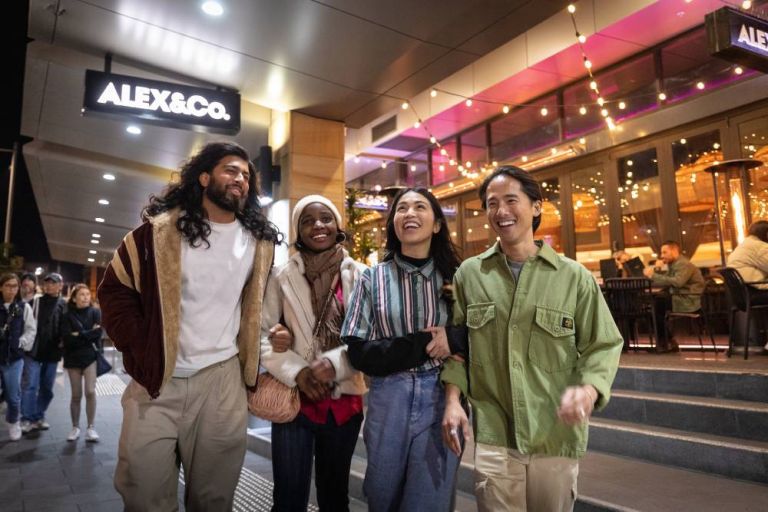What is Purple Flag?
Sydney is one of about 90 global destinations that have the Purple Flag. Stockholm, Sweden, Aberdeen, Scotland, Dublin, Ireland and Auckland, New Zealand are also part of this group.
Sydney's first accrediated areas are YCK (York, Clarence, and Kent Streets) in the CBD, as well as Parramatta CBD and Haldon Street, Lakemba.
When you see the Purple Flag sign, you’ll know the area meets standards of excellence in vibrancy, diversity and safety at night. This includes good access to public transport, street lighting and great food and beverage.
The Purple Flag program is a key initiative of the NSW Government’s 24-Hour Economy Strategy.
A proposed Purple Flag area in Marrickville is also part of the pilot program.
Benefits of Purple Flag
Accredited areas have reported benefits including:
a raised profile and improved public image for the area
wider patronage, and increased expenditure
reduction in crime and anti-social behaviour
more effective promotion of the area’s night-time economy
a more successful mixed-use economy in the longer term.
Purple Flag also helps and strengthens other work done by the public and private sector. This includes projects to bring places back to life, boost the economy at night, and keep the public safe.
What's the application and assessment process for Purple Flag?
Formal applications for Purple Flag will open in 2024 following an evaluation of the pilot program. Express interest or for more details by emailing 24hour@enterprise.nsw.gov.au
Interested future applicants will need to:
First express their interest in applying for Purple Flag.
Appoint a Purple Flag Coordinator and form a representative working group.
Conduct an overnight self-assessment report on the proposed area.
Prepare the rest of the application, including a summary of how the area meets the assessment criteria (see below).
Submit the application.
What's the estimated timeframe for Purple Flag accreditation?
The application process can take three to six months to complete.
How does an area get Purple Flag accreditation?
Purple Flag applications are assessed by independent assessors and an accreditation panel. They evaluate based on five core principles. For each Core Principle there are six attributes that must be met.
The Purple Flag Core Principles and Attributes
- Safety. Proportionate levels of visible, effective policing, capable guardians that can de-escalate situations before they occur and active surveillance.
- Care. Responsible guardianship, customer care and concern for community health.
- Regulation. Positive and proactive approach to licensing and regulation.
- Services. Appropriate levels of cleansing and waste, and access to public amenities.
- Partnership. The active involvement of business, liquor accords or other associations in contributing to a welcoming, clean and safe precinct.
- Perceptions. A valid and positive presentation of the area to customers.
- Public transport. Safe, affordable, well-managed late-night public transport, including adequate provision for taxi, ride share and other on-demand drop-off and pick-up services.
- Car parking. Where appropriate, availability of secure late-night car parking.
- Pedestrian routes. Clear, safe and convenient pedestrian links within the precinct and when leaving the area.
- Crowd management. Where applicable, measures to deal with overcrowding, congestion, and conflict between pedestrians and moving vehicles.
- Information. Practical information and guidance available for visitors to the area.
- Partnership. Business, venues and transport operator commitment and participation to support the safe movement of people and vehicles.
- Food and dining. A diverse choice of food venues including affordable options.
- Pubs and bars. Well-managed venues. Catering to varied tastes, including regular programming or cultural activities as appropriate to the area.
- Late night venues. Where applicable, diversity in late night venues (trading after 9pm) beyond food and drink options including but not limited to entertainment and shops. The late-night offer should complement the diverse appeal of the precinct as a whole.
- Early evening activity. An active early evening period, such as late opening shops, sporting and leisure opportunities, and night markets that offer a diverse appeal to all age groups.
- Building use. Creative and imaginative use of buildings in the evening and at night.
- Arts and culture. A vibrant, inclusive arts and cultural scene either through regular programming in venues or/and through events.
- Location. Appropriate location, clustering, and capacity of venue types and amenities.
- Diversity. A successful balance of uses.
- Clarity. Clear, accessible pedestrian links and wayfinding.
- Animation. Attractive, well-used public places, active streets and building frontages.
- Good design. Thoughtful and imaginative design for the night.
- Identity. Character and identity through natural and built features to reinforce appeal in addition to social, historical, and cultural significance and connections to community.
- Data. Access to data to support a sound statistical base for policy-making and action.
- Strategy. Positive strategic objectives and targets.
- Coordination. Public policy and regulatory coordination and focus.
- Leadership. Clear responsibilities for policy and action.
- Partnership. Multi-sector endorsement and commitment across local and state government agencies, private businesses, associations, and liquor accords.
- Community. Dialogue with consumers and residents.
For more information
For more information see the 24-hour economy pages.
For more information on Purple Flag email 24hour@enterprise.nsw.gov.au
